Bus Radio Red Light Continuous Tone
What types of signal lamps exist?
A range of different signal lamps or indicator lights is available for optical signaling. Each signal lamp differs in its function and the purpose of signaling. These include:
- Strobe lights
- Flashing beacons
- Rotating beacons
- Continuous light
- Mutlifunction beacons
Additionally, the different signal lamps from Auer Signal are available with the mounting options panel-mounting and surface-mounting.
LIGHT CHARACTERISTICS OF SIGNAL LAMPS
Every signal lamp or indication device has its own light characteristic or light pattern. A perfect example can be seen at the sea. Mariners rely on different light signals for communication and navigation. The signals can vary in light sequence and/or its colour depending on the intended area of application. This just shows how important it is in general, to choose the right signal lamp.
Light patterns can be the ones named above: Strobe, flashing (or blinking), rotating, continuous (fixed lights) and multicolour. But they can also be occulting light, isophase light, quick light, alternating light and Morse code.
To go back to the application at sea, fixed lights are commonly used for lighthouse regulations. They provide mariners with directional information regarding harbours or ports. The colours of the light for this area of application are red and green.
THE DIFFERENCE BETWEEN SIGNALLING AND INDICATION DEVICES
Signal lamps are very unlikely to be found in office spaces or factories where a bright or a warm light is often needed. That is, because they are indication devices which are used to provide a specific status update, also including warnings. Optical Signaling devices on the other hand are used to light up spaces. Both devices play important roles for many industrial applications.
What is a strobe light?
A strobe light produces a repeated, rapid flash of light in the millisecond range. The flashing light attracts the highest attention among all signal lamps. Strobe lights are therefore among the signal lamps with the best signal effect and are, for example, combined with audible signaling devices an important part of modern security systems.
Since the human eye reacts to movements in the field of vision, strobe lights cause a high level of attention. Flash is a very fast event and is very bright, which is why it is perceived even when the signal lamp is not in the direct field of vision. Reflections are sufficient to detect the warning signal of a strobe light.
The origin of the strobe light can be traced back to photography. There the short exposure time with a flashlight is sufficient to produce a photo.
Industrial applications in which strobe lights are used have a very high-risk potential. The strobe lights primarily serve to draw attention to potential hazards and other safety concerns. Strobe lights from Auer Signal are used, for example, on special vehicles with cranes, construction cranes and mining machines.
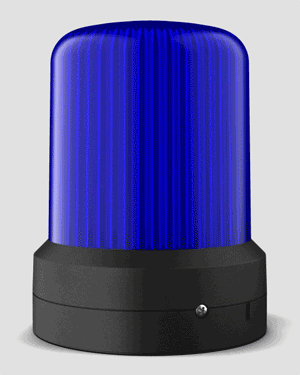
strobe light
WHICH LIGHTING TECHNOLOGIES ARE USED FOR STROBE LIGHTS?
Auer Signal strobe lights are available in Xenon and LED technology:
Xenon
Xenon strobe lights store the electrical energy in a capacitor and release it abruptly through a xenon flash tube, which creates the light pulse.
LED
LED strobe lights or LED multi strobe lights from Auer Signal use modern high-power LEDs as illuminants. Although an LED multi strobe light does not emit the same amount of light in the peaks as a xenon strobe light, it can compensate for the lower light output by a sequence of light pulses that significantly increase attention. In this way, the LED multi strobe light also achieves a very good signal effect. In contrast to xenon strobe lights, the LED strobe or multi-strobe lights offer all the advantages of LED technology: a very long service life, significantly better efficiency and unbeatable resistance to vibration.
FLASH FREQUENCIES OF STROBE LIGHTS
Strobe- and multi strobe lights from Auer Signal are available in different frequencies. The flash frequency is given in Hertz. This ranges from 1 Hz, 1.4 Hz to 2 Hz. In general, 1 Hz applies to 60 flashes per minute.
Strobe lights with a flash frequency of 1.4Hz reduce the tendency to epilepsy, which can be triggered by rapid changes in light. The flash frequency of 1Hz, on the other hand, is used in the more powerful strobe lights to increase the energy of the single flash.
COMBINATIONS OF A STROBE LIGHT WITH AN AUDIBLE SIGNAL
For an additional audible signaling of a strobe light there are visual-audible combination devices from Auer Signal. With these devices, a strobe light is combined with an audible signaling device. The following audible combinations with a strobe light or multi strobe light or multi strobe light are available in the Auer Signal range:
Multi strobe lights and strobe lights with piezo buzzer
The strong visual signaling of the Q series lights is amplified by a piezo buzzer attached to the housing. The piezo buzzer achieves a volume of 80 to 105 dB.
Multi-tone alarm sounder with strobe light indicator
If the strobe light is required in addition to an audible signal transmitter, there are combinations of the multi-tone alarm sounders of the A series, combined with small strobe light indicators. The strobe light indicator is located on the top of the alarm sounder.
Multi-tone alarm sounder with strobe light and multi strobe light
If two equally strong visual and audible signals are required, the combinations of Series A multi-tone alarm sounders and Series Q strobe lights are suitable. In the combination Series A&Q both signal-strong devices are combined by mounting the separate devices one above the other.
Alarm sounder with strobe light: The unmistakable sound of a horn can be combined with a strobe light at Auer Signal. The light is mounted above the horn. This means that in case of danger, a light signal can be emitted in addition to the classic horn sound.
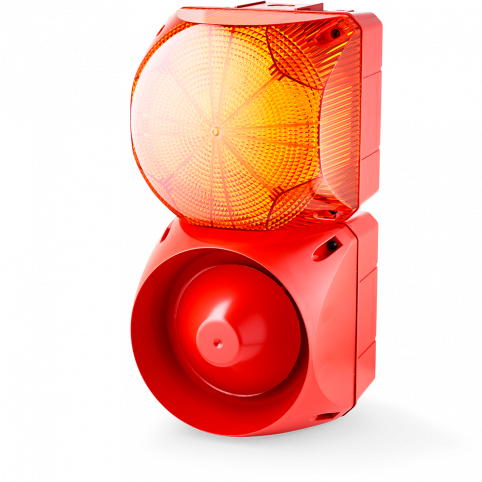
Series A&Q
WHAT COLOURS OF STROBE LIGHTS ARE AVAILABLE?
Strobe lights from Auer Signal are available in all standard colours. This includes red, yellow, green, orange, blue and clear. Particularly popular colours for the use of strobe lights are the signal colours red and orange.
STROBE LIGHTS ARE SUITABLE FOR
PLANT CONSTRUCTION
ELECTRICAL WHOLESALE TRADE
WOOD PROCESSING INDUSTRY
CRANE CONSTRUCTION
LOGISTIC FACILITIES
MECHANICAL ENGINEERING AND AUTOMATION
SPECIAL VEHICLES
DOOR & GATE
What is a flashing beacon?
Flashing beacons light up at equal intervals, creating a blinking light. Attention is therefore generated by a uniform lighting up and switching off of the light. Due to the even lighting up, a flashing beacon does not signal such an extraordinarily high warning as a strobe light. However, more attention is attracted by the periodic flashing than with a continuous light. This characteristic makes flashing beacons suitable for areas where the light signal needs to be clearly perceived but where the high attention level of a strobe light is not required.
As with strobe lights, the flashing or blinking frequency for flashing beacons is between 1 and 2 Hz.
The flashing of a flashing beacon or a blinking light usually requires the subsequent action of an employee. The flashing signal indicates different or faulty states that require action.
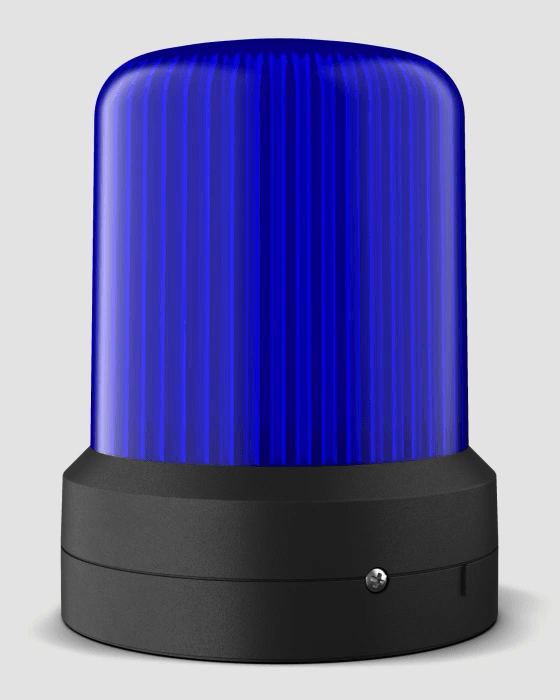
flashing beacon
COLOURS AND LIGHT TECHNOLOGIES OF FLASHING BEACONS
Auer Signal flashing beacons are available in red, yellow, green, orange, blue and clear. Which colour is best suited for your application can be found in our signal colours category.
Flashing beacons from Auer Signal are available as halogen or LED models. Lights with the functions continuous flashing light are available in LED technology.
HOW DOES A FLASHING BEACON WORK?
The flashing of incandescent lamps, halogen lamps or LEDs is generated by electronic switches which continuously switch the light source on and off. Alternatively, a control unit in the applications themselves can make a continuous beacon flash.
Usual flashing frequencies are between 1Hz and 2Hz. Especially with more powerful incandescent or halogen lamps, a faster flashing frequency is not appropriate, because the tungsten wire only glows after a certain time and after the voltage is switched off. Especially LED steady beacons can also be switched externally at frequencies higher than 2 Hz, as they normally switch on and off with a short delay.
The pulse duty cycle for flashing lights describes the ratio of on and off time of a light in flashing mode. Usually this is 1:1, which means that the time of glowing and non-glowing is equal. Other ratios can also be used. If the on time is very short, a flash light can be simulated with it.
COMBINATION OF A FLASHING BEACON WITH AN AUDIBLE SIGNAL
To increase the signal effect of a flashing beacon, the signal lamps are often combined with an audible device. Visual-audible combinations with flashing beacons from Auer Signal are available in the following designs:
- Steady-/Flashing beacons with buzzer indicator
- Mutli-tone alarm sounders with steady-/flashing light indicator
- Mutli-tone alarm sounders with steady-/flashing beacons
- Steady-flashing beacons with piezo buzzers
- Panel-Mounted buzzer with steady-/flashing beacons
- Signal horns with steady-/flashing beacons
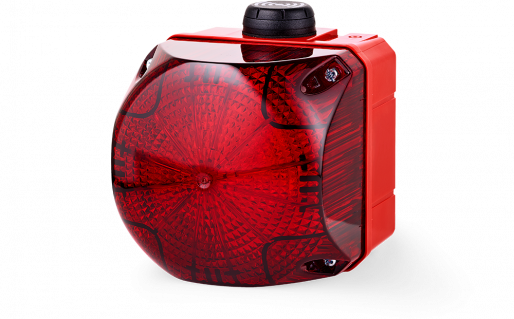
QSS
Often the functions steady light and flashing light are displayed in one light. Continuous light and flashing light can usually be controlled externally. Depending on the acoustic device, an acoustic signal of up to 120 dB can sound in addition to the light signal.
FLASHING BEACONS ARE SUITABLE FOR
PLANT CONSTRUCTION
ELECTRICAL WHOLESALE TRADE
WOOD PROCESSING INDUSTRY
CRANE CONSTRUCTION
LOGISTIC FACILITIES
MECHANICAL ENGINEERING AND AUTOMATION
SPECIAL VEHICLES
DOOR & GATE
What is a steady beacon?
A steady beacon emits a permanent light signal, without interruptions or changing light intensity. They are thus among those optical signaling devices that attract the least attention.
Steady beacons usually indicate the status of a device or an application. The colors red and green are often used for this purpose. The color green signals the operation or the normal state of a machine or an application. In exactly the same way, green light can stand for free access as in the traffic light principle, as it is used in cargo ports, for example.
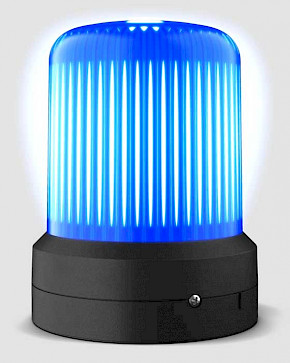
stea dy beacon
COMBINATION OF A STEADY BEACON WITH AN AUDIBLE SIGNAL
The following steady beacons combined with an audible signal transmitter can be found at Auer Signal:
- Steady-/Flashing beacons with piezo buzzer indicator
- Multi-tone alarm sounder with steady light indicator
- Multi-tone alarm sounder with steady-/flashing light indicator
- Multi-tone alarm sounder with steady beacon
- Multi-tone alarm sounder with steady-/flashing beacon
- Piezo buzzer with steady-/flashing beacon
- Panel-Mounted buzzer with steady beacon
- Panel-Mounted buzzer with steady-/flashing beacon
- Signal horn with steady-/flashing beacon
The steady beacon function is often available in combination with a flashing beacon. With these signal lamps, the steady light or flashing light function can be controlled externally.
COLOURS OF STEADY BEACONS Auer Signal steady beacons are available in the standard signal colours. Most models are available in these colours. These include the colours red, yellow, green, blue, orange and clear.
Auer Signal multicolour beacons also belong to the steady beacons, as they represent the steady light function in addition to the selection of different colours. Our top multicolour models of the R series can display seven colours. These include the colours red, yellow, green, blue, clear, magenta and turquoise.
More about the importance of color in signaling can be found in our category signal color explanation.
WHICH LIGHTING TECHNOLOGIES ARE USED FOR STEADY BEACONS?
Steady beacons from Auer Signal are available in three different lamp designs:
- LED
- Halogen
- Incandescent lamp
Which lightning technology is best suited for your application can be found in our category lighting technologies.
STEADY BEACONS ARE SUITABLE FOR
PLANT CONSTRUCTION
ELECTRICAL WHOLESALE TRADE
WOOD PROCESSING INDUSTRY
CRANE CONSTRUCTION
LOGISTIC FACILITIES
MECHANICAL ENGINEERING AND AUTOMATION
DOOR & GATE
AUTOMOTIVE INDUSTRY
BUILDING SERVICES ENGINEERING
SWITCH CABINET CONSTRUCTION
CONTROL TECHNOLOGY
What is a rotating beacon?
Rotating beacons are signal lamps that emit light in a 360° range. They work similar to the roving spotlight of a lighthouse. They are commonly used for special- and emergency vehicle lighting (red or blue light). Rotating beacons with the colour Amber (Link zu Farben) are used on large vehicles carrying heavy cargo.
Due to the 360° beam angle, the light signal of a rotating beacon can be perceived equally well by all road users.
Further applications of rotating beacons are the signaling in case of danger of machines or alarm systems. Due to their particularly high level of perception, they serve as warning lights for dangerous situations.
The best-known type of rotating beacon is the rotating mirror beacon.
WHAT IS THE DIFFERENCE BETWEEN A ROTATING MIRROR BEACON AND A ROTATING BEACON?
Classic rotating mirror beacons have a semi-circular mirror inside the dome. This mirror surrounds the light source, so that when it is rotated, the light spot is radiated in a certain direction. By rotating the mirror, the light is radiated in a range of 360°. This so-called rotating beam of light generates high attention, which can be increased or decreased by adjusting the speed of rotation.
In classic rolling bearings, the forces occurring between the parts that move relative to each other are transmitted by rolling elements, the so-called rolling elements. These rolling elements can be cylinders, balls or needles. Rolling bearings require lubrication.
With plastic plain bearings there are no moving parts. The bearing elements slide against each other. This results in sliding friction, in contrast to rolling friction in rolling bearings. Plain bearings are made of high-performance polymers that do not require lubrication. They are light, maintenance-free and corrosion-free. They are nevertheless very robust, even against vibrations or shocks. Plain bearings have excellent sliding properties over the entire temperature range.
The term rotating mirror light is often used as a synonym for rotating beacon or rotating light. However, the term rotating mirror beacon is only used correctly if a mirror is actually installed inside the beacon.
The term rotating beacon therefore stands for all those luminaires that emit moving light at a 360° beam angle without the rotation being generated by a mirror. Rotating beacons from Auer Signal generate the rotation by the rotating illumination of LEDs, which are attached to sticks inside the dome.
ROTATING BEACONS AS HALOGEN OR LED?
Rotating beacons in LED technology from Auer Signal are available in the R series as multifunctional models in two performance classes. The multifunctional beacons in Standard Performance are equipped with 6x6 LEDs. Multifunctional beacons in High Performance are equipped with 6x12 LEDs. The advantage of modern LED technology makes it possible to offer multifunctional beacons of the Series R in one size but two performance classes. Thanks to a sophisticated control of the LEDs, the light does not appear to be ticked off, but glides continuously.
At Auer Signal you will find halogen technology rotating mirror beacons of the M series in three different sizes. Depending on the size of the rotating mirror beacons, a halogen lamp of 20 to 50 Watt is installed inside the dome. The size of the light is in proportion to its luminosity.
Compared to halogen lamps, LEDs are many times more resistant, have a longer life and achieve enormous luminosity regardless of their size. You can find out more about the illuminants in the lighting technology section.
ROTATION SPEED OF ROTATING BEACONS
M series rotating mirror beacons and the R series rotating light function rotate at a constant speed of 90 or 180 rpm. The speed can be adjusted manually. The speed remains constant regardless of temperature or environment.
Rotating beacons in Europe are traditionally operated at 180 rpm. In America mainly with a speed of 90 rpm.
COMBINATION OF A ROTATING BEACON WITH AN AUDIBLE DEVICE
You will find the rotating beacon function at Auer Signal in the multi-function beacons of the R series. These models can be combined with the acoustic base RBA. Thus the rotating beacon can be amplified with a signal tone. The acoustic basis is based on the transducer technology of the ASS-T multi-tone sounder, reaches up to 95 dB and can reproduce 32 tones.
COLOURS OF ROTATING BEACONS IN ROAD TRAFFIC
Halogen rotating mirror beacons from the M series are available in orange, yellow, red and green. The LED multi-function beacons of the R series, which can display the function of rotating light, are available in the colours red, yellow, green, blue, orange and clear.
Particularly in road traffic, the use of rotating beacons in the different colours must be carefully considered. In Austrian road traffic, rotating beacons must comply with the Motor Vehicles Act 1967. Lights with rotating or flashing lights on vehicles are only permitted as warning lights. If necessary, the signal lamp on the vehicle must be tested and approved by the authorities.
Colours which are used on vehicles in road traffic:
- Yellow rotating light: The colour yellow warns of all kinds of dangers. Yellow flashing light is used, for example, as a charging warning light on attachments or lifting platforms. This rotating beacon can also be found on breakdown and towing vehicles.
- Blue rotating light: May be used including emergency vehicles such as rescue or fire engines.
- Red and green rotating light is prohibited in Austria and Germany for vehicles in road traffic.
Read more about the different colours in signaling here.
ROTATING BEACONS ARE SUITABLE FOR
PLANT CONSTRUCTION
ELECTRICAL WHOLESALE TRADE
WOOD PROCESSING INDUSTRY
CRANE CONSTRUCTION
LOGISTIC FACILITIES
MECHANICAL ENGINEERING AND AUTOMATION
SPECIAL VEHICLES
DOOR & GATE
What is a panel-mounted light?
A panel-mounted light or panel-mount indicator is mounted in a drill hole. First a 22.5mm hole is drilled or punched with a special tool. Then the light is inserted from the front and fixed from behind with a nut. The standard 22.5mm hole has a recess for an anti-twist lug, which is also found on our devices. After the lamp has been installed, it cannot be turned from the front afterwards.
Panel-mounted lights are particularly suitable for signaling in switch cabinet and panel construction. But the small panel-mounted lights are also used in the automation of control and regulation technology. They provide information on the operating status or report faults.
Auer Signal panel-mounted lights are available as LED and Xenon versions. Find out which signal technology is best suited to your application here.
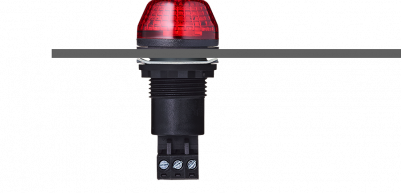
IBS M22 Panel-mounted light
Panel-mounted lights are available with the following functions:
- Panel mount beacon with LED strobe beacon
- Panel mount beacon with LED multi strobe beacon
- Panel mount beacon with LED strobe/flashing beacon
- Panel mount beacon with LED multi-colour light
- Panel mount beacon with Xenon strobe light
COLOURS OF PANEL-MOUNTED LIGHTS
Depending on the model, panel-mounted lights from Auer Signal are available in the following colours:
- Orange
- Red
- Clear
- Blue
- Green
- Yellow
With multicolour panel-mounted lights, the colours red or green or optionally red, yellow and green can be controlled externally. Want to learn more more about the importance of colour in signaling? Read more about it here.
VISUAL-AUDIBLE PANEL-MOUNTED LIGHTS
In addition to the panel-mounted signal lamps, there are also visual-audible panel-mounted variants. These models consist of a built-in buzzer combined with an LED steady beacon or LED steady/flashing beacon. The products of the M22 series can be found in the category of visual-audible panel mount devices. The installation dimension of the devices has a diameter of 22.5mm and can be extended to 30.5mm with the adapter ADM30.
PANEL-MOUNTED LIGHTS ARE SUITABLE FOR
PLANT CONSTRUCTION
ELECTRICAL WHOLESALE TRADE
WOOD PROCESSING INDUSTRY
LOGISTIC FACILITIES
MECHANICAL ENGINEERING AND AUTOMATION
DOOR & GATE
AUTOMOTIVE INDUSTRY
BUILDING SERVICES ENGINEERING
SWITCH CABINET CONSTRUCTION
CONTROL TECHNOLOGY
What is a surface-mounted light?
A surface mounted light or surface mounted indicator is mounted on top of a flat surface. This can be a a ceiling, a device, a machine, a wall or any other object. Typical mounting options include horizontal and vertical mounting directly on the base, mounting using brackets and pipe mounting.
Surface mounted lights from Auer Signal are available with the following lighting functions:
- Strobe lights
- Steady-/Flashing beacons
- Steady beacons and multicolour beacons
- Flashing beacons
- Rotating mirror beacons
- Mutlifunction beacons
The surface mounted lights are available in all common standard colours. You can find out which signal colour is the right one for your application as well as the different meanings of each colour in the section "beacon light colours".

Various mounting options for surface mounted lights
Surface mounted luminaires are available in the following different lighting technologies:
- LED
- Xenon
- Halogen
- Incandescent lamp
AUDIBLE-VISUAL SURFACE-MOUNTED LIGHTS
To amplify the visual signals of surface mounted lights, there are visual-audible combinations from Auer Signal. The following signal transmitters are available in combination with a surface mounted luminaire:
- Signal lights piezo buzzer indicator
- Multi-tone alarm sounders with signal lamps indicator
- Multi-tone alarm sounders with beacons
- Piezo buzzer with beacons
- Signal horns with beacons
SURFACE-MOUNTED LIGHTS ARE SUITABLE FOR
PLANT CONSTRUCTION
ELECTRICAL WHOLESALE TRADE
WOOD PROCESSING INDUSTRY
LOGISTIC FACILITIES
MECHANICAL ENGINEERING AND AUTOMATION
DOOR & GATE
AUTOMOTIVE INDUSTRY
BUILDING SERVICES ENGINEERING
SWITCH CABINET CONSTRUCTION
CONTROL TECHNOLOGY
CRANE CONSTRUCTION SPECIAL VEHICLES
Comparison of signaling devices
| Suitability | Steady beacon | Strobe light | Rotating beacon | Flashing beacon |
| Standard condition | Yes | Yes | No | No |
| Minor errors and defects | Yes | Yes | No | No |
| Serious errors and defects | Nein | Yes | Yes | Yes |
| Dangerous situations | No | No | Yes | Yes |
| Application | Panel-mounted beacon | Surface-mounted beacon |
| Control panel | Yes | No |
| Control cabinet | Yes | No |
| Vehicles | Yes | Yes |
| Cranes | No | Yes |
| Electric gate | No | Yes |
| Production machine | Yes | Yes |

pellegrinwaysainew.blogspot.com
Source: https://www.auersignal.com/en/technical-information/visual-signalling-equipment/signal-lamps/
0 Response to "Bus Radio Red Light Continuous Tone"
Enregistrer un commentaire